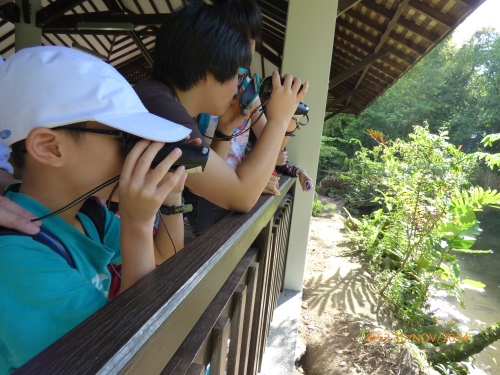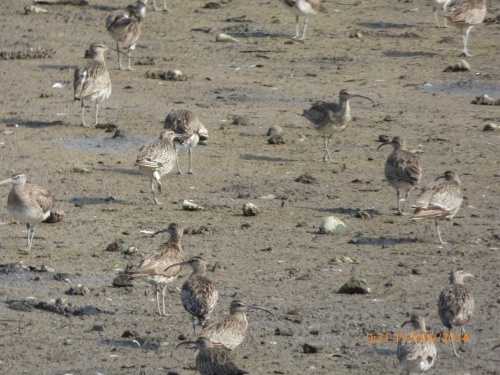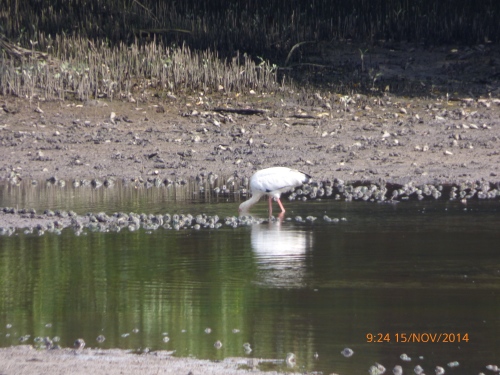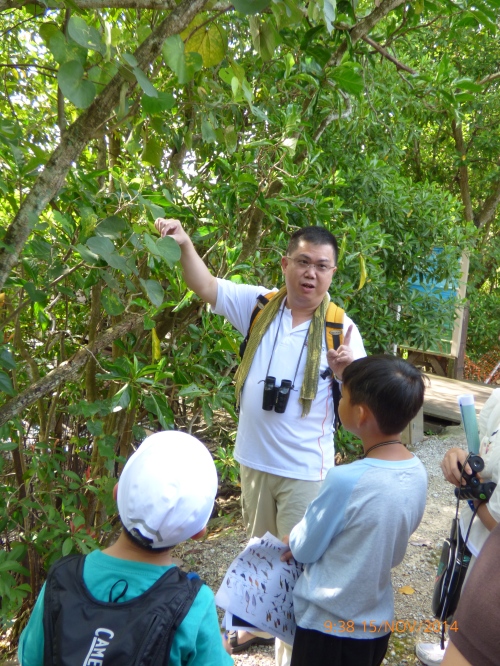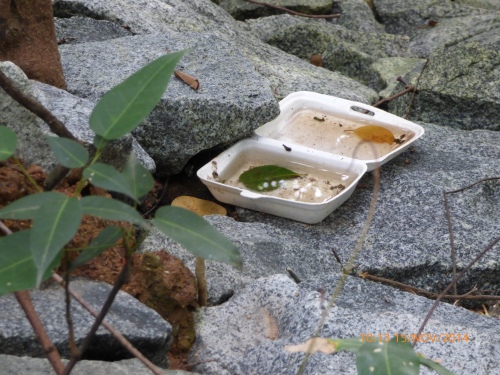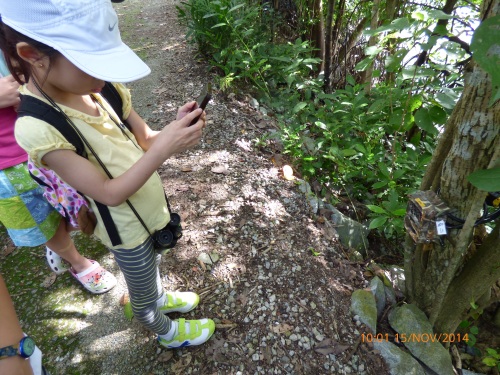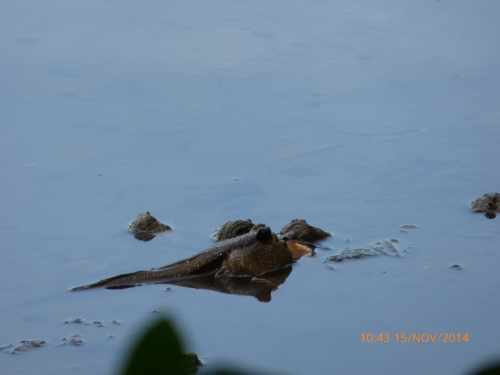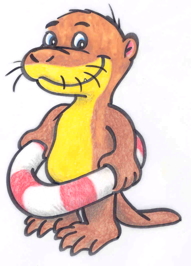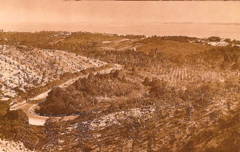Last Saturday, on 15 Nov 2014, Sungei Buloh Wetland Reserve (SBWR) was buzzing with the excitement of some 40 young champions of nature and nominees for this year’s Green Carpet Awards (GCA). “BirdBlitz”, organized by World Edu Corp, brought together representatives of the birding community from Nature Society (Singapore) (NSS), Nature Photographic Society, Singapore (NPSS) and NUS to allow the students to experience bird conservation and research, first hand. The NSS birders and their young assistants did a count of migratory birds, NPSS photographers learned about bird behaviour while snapping away, and the NUS researchers hiked through the mangrove forest to understand its ecology, its role as habitat for birds, as well as conservation challenges.
Six Toddycats and friends from the department were present for the event – Kok Oi Yee (Toddycats), Alvin Wong (Toddycats), David Tan (Toddycats, Avian Genetics Lab), Keren Sadanandan (RA, Avian Genetics Lab), Chloe Tan (Toddycats, RA, Applied Plant Ecology Lab), Vivien Lee (RA, Applied Plant Ecology Lab). Ng Wen Qing from the Freshwater and Invasion Biology Lab was unwell to join us.
The young researchers were just getting acquainted with their new binoculars when our first bird sighting for the day – a noisy White-breasted Waterhen (Amaurornis phoenicurus), sent them peering across the pond.
When we ventured onto the Main Bridge, the students could barely contain their excitement with all the birds flying around and fishes swimming under the bridge. Here, they tried their hands at identifying shorebirds (very challenging!) for the first time, using the field guide issued by the organizers. We also spent some time orientating them and explaining how SBWR’s geographical position on the northern coast of Singapore contributes to the habitat here. Some of the students were surprised at how narrow the Johor Strait is, such that they could see Johor Bahru from here! Singapore is also part of the East Asian-Australasian Flyway, one of the major flyways of the world, which birds use to travel from their breeding grounds in the higher latitudes to their wintering grounds here in the tropics and southern hemisphere. SBWR lies along this flyway, serving as a crucial feeding and resting stop for migrating birds.
Things got even more exciting when we approached the mudflats – the perfect stage for students to learn how the diversity in form of the birds (e.g. bill and leg length) allows different species to come together to feed in the same place. Using Alvin’s drinking straw analogy, if you have a short straw you can only drink the foam of your Coke; if you have a longer straw, you can drink from deeper in the cup. Here, we saw several species of migratory shorebirds including the Common Sandpiper (Tringa hypoleucos) and Whimbrel (Numenius phaeopus). A Milky Stork (Mycteria cinerea) was also seen hunting for fish. David intrigued the older students when he shared about the hybridization between Milky and Painted Storks, both of which are free-ranging birds from the zoo or bird park. Of course, he also went on to talk about how he has been collecting samples from birds, dead or alive, for genetic studies.
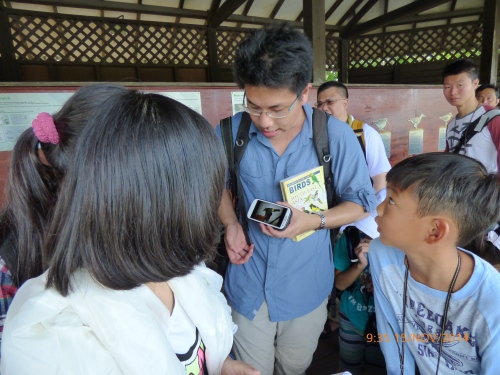
David showing a picture of a dead Yellow-rumped Flycatcher (Ficedula zanthopygia) he recently collected.
Further along the trail, we touched on the various aspects of mangrove ecology. The Sea Hibiscus (Talipariti tiliaceum) with its distinctive leaf shape and symbiotic relationship with ants left a strong impression among the students. They whipped out their smartphones synchronously when we spotted some other critters like a mating pair of stink bugs, St. Andrew’s cross spiders, Plantain Squirrels (Callosciurus notatus) and Malayan Water Monitors (Varanus salvator)!
Tuning in to the sounds of the mangrove, Oi Yee took out a canister containing a dead cicada and a molt, fascinating us all!
The mangrove may seem well and alive, but it is constantly under threat by human impacts such as littering and high boat traffic that hastens erosion. We saw a Rhizophora tree that had fallen, despite its well-developed network of prop roots.
As biologists, one of our objectives for the event was to show the young ones how scientific studies on wildlife are conducted. We came across a camera trap along the trail and explained to the curious kids how the device is useful for studying mammals. Turning back from Platform 1, we noticed an unusual bunch of sticks tied to a tree. Upon a closer look, there was a tag which read “Research in progress. DO NOT DISTURB”, and the name of our colleague from the department who studies bees. Eunice Soh must have installed this stick nest to study the bees in the Reserve!
One of the major threats to conservation is habitat modification by humans. SBWR was largely used for prawn farming in the past, and the sluice gates enclosing the mudflats are an evidence of its history. Oi Yee showed us how the sluice gates can be operated to control water level in the prawn ponds. Now that the area has been returned to nature, these gates are used still used to control water levels. For example, water can be kept out of the ponds even during high tide to allow migratory shorebirds to feed on the mudflats.
On the way back to the visitor centre, many other creatures made their appearance. There were a Little Heron (Butorides striata), Little Egret (Egretta garzetta), mudskippers and crabs.
Back at the visitor centre, the students gathered to complete their handouts, putting together what they had learned during the walk.
Rounding off the event were two prominent figures from National Geographic – Dr. Greg Marshall, a Nat Geo Fellow, and Dr. Francis Downey, Vice-president and Publisher of Nat Geo Learning. The biologists in us related well with Dr. Marshall, who invented Crittercam, as he shared about his past work and upcoming project on cheetahs in Botswana!
A couple of the young environmental advocates attended a press conference on Monday (17 Nov 2014) to share their experiences during this programme. We hope that they are inspired to keep up their good work as voices for nature!




